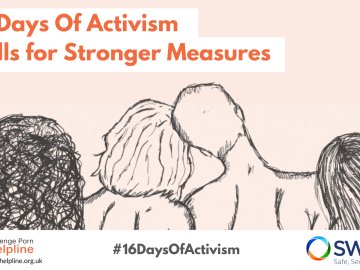When the Women and Equalities Committee (WEC) released its landmark report on non-consensual intimate image (NCII) abuse, it offered a rare moment of clarity: a survivor-informed, evidence-led roadmap to close glaring gaps in UK law. The Committee’s recommendations were practical, balanced, and achievable.
Yet the Government’s official response falls far short—rejecting or partially rejecting 14 of the Committee’s 19 recommendations. Instead of decisive action, it offers vague assurances and procedural delay. The result is a stance that feels not only disconnected from the lived reality of victims but one that is also difficult to reconcile with the Government’s wider ambition to reduce violence against women and girls.
The Human Cost of Inaction
Behind each of these rejected recommendations is a survivor who wakes up knowing their most intimate images may be circulating online. Some live in fear of re-uploading, blackmail, or abuse. Others face housing loss, employment impacts, or mental health crises—often without feeling believed or protected—all without a realistic legal path to stop the harm. It is this ongoing reality that makes the Government’s response so difficult to reconcile.
Throughout its response, the Government repeatedly argues that new measures would be too difficult to implement, are already covered by existing powers, or are unlikely to add value in practice. This logic underpins many of the rejections—and fails to engage with the unique realities of NCII abuse. As the following three examples show, this reasoning does not stand up to scrutiny.
A Pattern of Public Disconnection
This disconnect is most stark in three key areas where the Government’s refusal to act is particularly difficult to justify:
1. Refusal to Create a Civil Redress Mechanism
Survivors need fast, accessible ways to get intimate images taken down. Yet the Government rejected a statutory civil route for takedown and compensation, claiming that existing criminal and civil procedures are sufficient.
This is incorrect. Criminal processes are slow, rare, and not suitable for many victims. Existing civil claims are prohibitively expensive and legally complex. A statutory civil mechanism (like the one operating in British Columbia) would allow survivors to quickly apply for removal orders and redress without needing a lawyer or going to court. It works elsewhere so why couldn’t it work here?
By focusing almost exclusively on the criminal law, the Government ignores the practical reality: survivors are asking for swift remedies, not deterrence alone. For most survivors, the choice is bleak: pay for legal action or accept continued harm. The absence of this mechanism leaves victims with no realistic pathway to stop the ongoing abuse. When victims are told their only option is an expensive, years-long legal battle (or nothing at all) the Government are not offering protection or justice.
2. Refusal to Extend Time Limits for Prosecution
Currently, survivors have just six months to report the base offences of taking or sharing intimate images. Yet many don’t even discover the abuse within that time—particularly when images are shared covertly or across borders.
The Committee rightly recommended extending this limit, in line with proposals already accepted for deepfake offences. But for reasons that remain unexplained, the Government refused to apply the same logic to these core offences.
This inconsistency is not just confusing, it’s harmful. The law is punishing victims for reporting too late, even when delays are outside their control. There is no clear rationale for retaining this limit. It’s a simple, low-cost legislative change that could make a profound difference. No one would accept a six-month window for reporting other forms of abuse. Why should survivors of intimate image abuse be treated differently?
3. Refusal to Criminalise Possession of NCII Material
In the UK, it is rightfully illegal to possess child sexual abuse material. But NCII content—images or videos shared without consent—can be retained and redistributed without consequence even if the perpetrator has been convicted or served a prison sentence.
This makes no sense. Possession enables blackmail, re-uploading, and long-term trauma. It facilitates continuing harm. Survivors live in fear of images being recirculated. Without a criminal possession offence, the law provides no barrier to this ongoing harm.
The Government’s refusal to act here puts it at odds with both survivor testimony and basic safeguarding principles. In its statement to the Women and Equalities Committee, the Government stated: “We do not believe that in practice this would achieve that outcome, due to the difficulties around establishing whether it was possessed without either consent or a reasonable belief in consent. It is also unclear what this would add, given existing powers that apply once an image has been unlawfully shared online.”
This response overlooks the real-world impact of possession. Possession is not passive—it facilitates continuing harm, including coercion, blackmail, and re-uploading. The same evidential hurdles cited here already exist in other areas of law, including child sexual abuse material (CSAM) offences, where courts routinely navigate questions of intent, knowledge, and belief. More importantly, this line of reasoning fails to grasp what survivors repeatedly say: the ongoing trauma is sustained not just by what has already been shared, but by what may be shared again.
The Government also asserts that existing post-sharing powers are sufficient. Yet the Women and Equalities Committee (and frontline practitioners) have shown that this is not the case. Content continues to circulate, often hosted on non-compliant sites overseas. Without a possession offence, there is no legal tool to remove this content at source, or to hold accountable those who retain and enable its circulation. It is a glaring gap in protection—akin to allowing someone to retain stolen property so long as they promise not to use it again. In no other area of criminal justice would we accept such passive tolerance of harmful material. We do not wait for stolen items to be re-used before acting; nor do we excuse possession of illegal material in cases of child sexual abuse. Yet when it comes to NCII, the law remains inexplicably silent. Why does it treat non-consensual intimate images as less serious?
Progression Without Innovation
Some progress has been made. But concerns about Government inertia are not confined to this issue alone. In its January 2024 report on tackling violence against women and girls, the Public Accounts Committee (PAC) warned: “We are concerned that government departments’ approach to tech–enabled violence against women and girls is not sufficiently agile to address the threats posed by online harm.” This echoes what frontline services and expert committees like the WEC have long stated: legislative and regulatory processes are not keeping pace with the speed or complexity of the harm.
We welcome the criminalisation of nudification apps and recognition of NCII under the Violence Against Women and Girls (VAWG) strategy. These are important, but incremental.
What’s missing is urgency and coherence. Survivors are still being asked to wait years for regulatory reforms while platforms and perpetrators continue to operate in the gaps. Even the Government acknowledges that Ofcom’s report on the effectiveness of user redress mechanisms will not be published until 2028—three years from now, according to the Government’s formal response to the Women and Equalities Committee. That timeline alone underscores why individuals experiencing harm today cannot rely on future systems alone.
On the very same day this response is being published, the United States President is signing the TAKE IT DOWN Act into law—a landmark move to give survivors a federal pathway for image removal and enforcement. The contrast could not be clearer. Where others are leading with innovation and resolve, the UK’s response appears confused, inconsistent, and out of step with both evidence and public expectation.
 What Needs to Happen Now – A Call for Immediate Action
What Needs to Happen Now – A Call for Immediate Action
SWGfL calls for immediate action, including:
A statutory civil redress mechanism;
Legal parity between NCII and CSAM in criminal law;
Extension of time limits for prosecution;
Mandatory adoption of proactive detection and takedown tools;
Clarification on how victims will get direct support.
These changes are not radical. They are reasonable, proportionate, and grounded in expert consensus. Implementing them would send a powerful message that NCII is not a niche issue, it is a serious form of abuse, deserving of a serious legal response.
Justice cannot wait for platforms to act voluntarily. It cannot be restricted to those with legal representation, those with significant personal funds, and it cannot be undermined by arbitrary deadlines.
Justice in this space must be accessible, enforceable, and survivor led. Anything less does not uphold justice, it postpones it, leaving victims, particularly women and girls, unprotected while the system catches up.
Reflect, Review and Rectify
SWGfL remains committed to working constructively with Government, Parliamentarians, regulators and industry partners to close the gaps that persist and to advance practical, survivor-informed reform. This response, though disappointing, is not final. There remains a clear opportunity to strengthen protections, deliver meaningful remedies, and restore public trust in how the system responds to intimate image abuse.
As Ministers reflect on this response, they must consider whether it aligns with the Government’s stated ambition to halve violence against women and girls within a decade. And in the broader international context—on the very day that the United States signs the federal TAKE IT DOWN Act into law, offering a clear pathway for image removal and enforcement—the UK’s reluctance to act decisively risks us falling behind.
This is not about political point-scoring. It is about whether our laws, our systems, and our leadership are capable of responding to the scale and immediacy of this harm. The Government’s current stance is disappointing, but not irreversible. We urge Ministers to reflect on what message this response sends to survivors, and whether it truly reflects the leadership and protection the UK seeks to demonstrate.
As the Chair of the Women and Equalities Committee, Sarah Owen MP, has said:
“While the new online safety regime has real benefits and the focus on systems and processes might lead to positive changes, it is not designed to tackle individual claims… victims cannot wait months or even years for action and redress.” By working with those on the frontline, the Government can still deliver the meaningful, survivor-centred reform that this moment demands.






